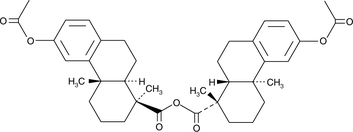Chemicals
Showing 8101–8250 of 41137 results
-
Aceclofenac ethyl ester is a potential impurity found in commercial preparations of aceclofenac (Item No. 28620).{42994}
Brand:CaymanSKU:22115 -Out of stock
Aceclofenac methyl ester is a potential impurity in commercial preparations of the NSAID aceclofenac (Item No. 28620).{42994} It has also been used as a precursor in the synthesis of aceclofenac.{42998}
Brand:CaymanSKU:22121 -Out of stock
Aceclofenac methyl ester is a potential impurity in commercial preparations of the NSAID aceclofenac (Item No. 28620).{42994} It has also been used as a precursor in the synthesis of aceclofenac.{42998}
Brand:CaymanSKU:22121 -Out of stock
Aceclofenac methyl ester is a potential impurity in commercial preparations of the NSAID aceclofenac (Item No. 28620).{42994} It has also been used as a precursor in the synthesis of aceclofenac.{42998}
Brand:CaymanSKU:22121 -Out of stock
Aceclofenac methyl ester is a potential impurity in commercial preparations of the NSAID aceclofenac (Item No. 28620).{42994} It has also been used as a precursor in the synthesis of aceclofenac.{42998}
Brand:CaymanSKU:22121 -Out of stock
Acemetacin is a non-steroidal anti-inflammatory drug (NSAID) and a prodrug form of indomethacin (Item No. 70270).{48888} It reduces zymosan-induced thromboxane B2 (TXB2; Item No. 19030) and prostaglandin E2 (PGE2; Item No. 14010) production in isolated rat whole blood and stomach, respectively, when administered at doses ranging from 2.7 to 83.8 µmol/kg. Acemetacin (1.3, 2.5, and 10 mg/kg) also reduces carrageenan-induced PGE2 production in rat synovial membranes.{48889} It decreases leukocyte infiltration in the exudate in a rat model of zymosan-induced air pouch inflammation when administered at doses of 27.9 and 83.8 µmol/kg.{48888}
Brand:CaymanSKU:29615 - 1 gAvailable on backorder
Acemetacin is a non-steroidal anti-inflammatory drug (NSAID) and a prodrug form of indomethacin (Item No. 70270).{48888} It reduces zymosan-induced thromboxane B2 (TXB2; Item No. 19030) and prostaglandin E2 (PGE2; Item No. 14010) production in isolated rat whole blood and stomach, respectively, when administered at doses ranging from 2.7 to 83.8 µmol/kg. Acemetacin (1.3, 2.5, and 10 mg/kg) also reduces carrageenan-induced PGE2 production in rat synovial membranes.{48889} It decreases leukocyte infiltration in the exudate in a rat model of zymosan-induced air pouch inflammation when administered at doses of 27.9 and 83.8 µmol/kg.{48888}
Brand:CaymanSKU:29615 - 10 gAvailable on backorder
Acemetacin is a non-steroidal anti-inflammatory drug (NSAID) and a prodrug form of indomethacin (Item No. 70270).{48888} It reduces zymosan-induced thromboxane B2 (TXB2; Item No. 19030) and prostaglandin E2 (PGE2; Item No. 14010) production in isolated rat whole blood and stomach, respectively, when administered at doses ranging from 2.7 to 83.8 µmol/kg. Acemetacin (1.3, 2.5, and 10 mg/kg) also reduces carrageenan-induced PGE2 production in rat synovial membranes.{48889} It decreases leukocyte infiltration in the exudate in a rat model of zymosan-induced air pouch inflammation when administered at doses of 27.9 and 83.8 µmol/kg.{48888}
Brand:CaymanSKU:29615 - 5 gAvailable on backorder
Acenocoumarol is an analog of the oral anticoagulant warfarin that functions by inhibiting vitamin K epoxide reductase, an enzyme that has a critical role in enabling blood coagulation.{15996} It is a brief-acting compound with a half-life of about eight hours in plasma, which is four times shorter than that of warfarin.{15997}
Brand:CaymanSKU:10010569 - 10 mgAvailable on backorder
Acenocoumarol is an analog of the oral anticoagulant warfarin that functions by inhibiting vitamin K epoxide reductase, an enzyme that has a critical role in enabling blood coagulation.{15996} It is a brief-acting compound with a half-life of about eight hours in plasma, which is four times shorter than that of warfarin.{15997}
Brand:CaymanSKU:10010569 - 100 mgAvailable on backorder
Acenocoumarol is an analog of the oral anticoagulant warfarin that functions by inhibiting vitamin K epoxide reductase, an enzyme that has a critical role in enabling blood coagulation.{15996} It is a brief-acting compound with a half-life of about eight hours in plasma, which is four times shorter than that of warfarin.{15997}
Brand:CaymanSKU:10010569 - 25 mgAvailable on backorder
Acenocoumarol is an analog of the oral anticoagulant warfarin that functions by inhibiting vitamin K epoxide reductase, an enzyme that has a critical role in enabling blood coagulation.{15996} It is a brief-acting compound with a half-life of about eight hours in plasma, which is four times shorter than that of warfarin.{15997}
Brand:CaymanSKU:10010569 - 50 mgAvailable on backorder
Acephate is an organophosphate insecticide that is active against a variety of insects.{39718} It inhibits acetylcholinesterase in the house fly with a topical 24-hour LD50 value of 1.8 µg/g but has millimolar IC50 values for vertebrate cholinesterases.{39719,39720} In rats, acephate (140 mg/kg) induces reversible hyperglycemia after two and six hours and increases plasma corticosterone, liver glucose-6-phosphate, and liver tyrosine aminotransferase.{39718} It also increases liver glycogen levels by 3.5-fold after six hours. Formulations containing acephate have been used in the control of insects in agriculture and horticulture.
Brand:CaymanSKU:24038 - 100 mgAvailable on backorder
Acephate is an organophosphate insecticide that is active against a variety of insects.{39718} It inhibits acetylcholinesterase in the house fly with a topical 24-hour LD50 value of 1.8 µg/g but has millimolar IC50 values for vertebrate cholinesterases.{39719,39720} In rats, acephate (140 mg/kg) induces reversible hyperglycemia after two and six hours and increases plasma corticosterone, liver glucose-6-phosphate, and liver tyrosine aminotransferase.{39718} It also increases liver glycogen levels by 3.5-fold after six hours. Formulations containing acephate have been used in the control of insects in agriculture and horticulture.
Brand:CaymanSKU:24038 - 25 mgAvailable on backorder
Acephate is an organophosphate insecticide that is active against a variety of insects.{39718} It inhibits acetylcholinesterase in the house fly with a topical 24-hour LD50 value of 1.8 µg/g but has millimolar IC50 values for vertebrate cholinesterases.{39719,39720} In rats, acephate (140 mg/kg) induces reversible hyperglycemia after two and six hours and increases plasma corticosterone, liver glucose-6-phosphate, and liver tyrosine aminotransferase.{39718} It also increases liver glycogen levels by 3.5-fold after six hours. Formulations containing acephate have been used in the control of insects in agriculture and horticulture.
Brand:CaymanSKU:24038 - 50 mgAvailable on backorder
Acepromazine is a phenothiazine antipsychotic, analog of chlorpromazine (Item No. 16129), and a dopamine receptor antagonist.{46374} It also binds to muscarinic receptors in rat brain (IC50 = 350 nM) and inhibits contractions of guinea pig ileum induced by acetylcholine (Item No. 23829; IC50 = 840 nM).{46375} Acepromazine inhibits morphine-induced vomiting in dogs.{46376} It also inhibits development of a conditioned avoidance response, unconditioned escape response, and catalepsy in rats (ED50s = 0.98, 3.1, and 17 mg/kg, respectively).{46377} Formulations containing acepromazine have been used as tranquilizers and anesthetics premedicant in small and large animal veterinary care.
Brand:CaymanSKU:27821 - 10 mgAvailable on backorder
Acepromazine is a phenothiazine antipsychotic, analog of chlorpromazine (Item No. 16129), and a dopamine receptor antagonist.{46374} It also binds to muscarinic receptors in rat brain (IC50 = 350 nM) and inhibits contractions of guinea pig ileum induced by acetylcholine (Item No. 23829; IC50 = 840 nM).{46375} Acepromazine inhibits morphine-induced vomiting in dogs.{46376} It also inhibits development of a conditioned avoidance response, unconditioned escape response, and catalepsy in rats (ED50s = 0.98, 3.1, and 17 mg/kg, respectively).{46377} Formulations containing acepromazine have been used as tranquilizers and anesthetics premedicant in small and large animal veterinary care.
Brand:CaymanSKU:27821 - 100 mgAvailable on backorder
Acepromazine is a phenothiazine antipsychotic, analog of chlorpromazine (Item No. 16129), and a dopamine receptor antagonist.{46374} It also binds to muscarinic receptors in rat brain (IC50 = 350 nM) and inhibits contractions of guinea pig ileum induced by acetylcholine (Item No. 23829; IC50 = 840 nM).{46375} Acepromazine inhibits morphine-induced vomiting in dogs.{46376} It also inhibits development of a conditioned avoidance response, unconditioned escape response, and catalepsy in rats (ED50s = 0.98, 3.1, and 17 mg/kg, respectively).{46377} Formulations containing acepromazine have been used as tranquilizers and anesthetics premedicant in small and large animal veterinary care.
Brand:CaymanSKU:27821 - 250 mgAvailable on backorder
Acepromazine is a phenothiazine antipsychotic, analog of chlorpromazine (Item No. 16129), and a dopamine receptor antagonist.{46374} It also binds to muscarinic receptors in rat brain (IC50 = 350 nM) and inhibits contractions of guinea pig ileum induced by acetylcholine (Item No. 23829; IC50 = 840 nM).{46375} Acepromazine inhibits morphine-induced vomiting in dogs.{46376} It also inhibits development of a conditioned avoidance response, unconditioned escape response, and catalepsy in rats (ED50s = 0.98, 3.1, and 17 mg/kg, respectively).{46377} Formulations containing acepromazine have been used as tranquilizers and anesthetics premedicant in small and large animal veterinary care.
Brand:CaymanSKU:27821 - 50 mgAvailable on backorder
Acequinocyl is a naphthoquinone acaricide that inhibits complex III of the mitochondrial electron transport chain in mites.{41976} Weekly application of acequinocyl (0.03 kg AI/100 L) to strawberry plants reduces seasonal averages of the number of T. urticae mites and mite eggs on plant leaflets.{41977} It is not toxic to rats or mice (LD50s = >5,000 mg/kg).{41976} Formulations containing acequinocyl have been used to control mite populations in agriculture.
Brand:CaymanSKU:25624 - 10 mgAvailable on backorder
Acequinocyl is a naphthoquinone acaricide that inhibits complex III of the mitochondrial electron transport chain in mites.{41976} Weekly application of acequinocyl (0.03 kg AI/100 L) to strawberry plants reduces seasonal averages of the number of T. urticae mites and mite eggs on plant leaflets.{41977} It is not toxic to rats or mice (LD50s = >5,000 mg/kg).{41976} Formulations containing acequinocyl have been used to control mite populations in agriculture.
Brand:CaymanSKU:25624 - 5 mgAvailable on backorder
Acesulfame-d4 is intended for use as an internal standard for the quantification of acesulfame by GC- or LC-MS. Acesulfame is a non-caloric sweetener used as a sugar alternative that is not metabolized by humans.{38050} Excreted acesulfame has been found in wastewater and is considered a pollutant.
Brand:CaymanSKU:27786 - 1 mgAvailable on backorder
Acetaminophen is an analgesic and antipyretic compound.{42476,42477} Unlike many NSAIDs, which inhibit both COX-1 and COX-2, early studies suggested that acetaminophen is a poor inhibitor of both isoforms.{1287,8427} However, it does inhibit COX-2 by 83% and COX-1 by 56% in human blood ex vivo, albeit at a high 1,000 mg dose, with IC50 values of 25.8 and 113.7 µM, respectively.{29484} Acetaminophen is enzymatically and non-enzymatically converted to several reactive metabolites that contribute to adverse or indirect effects, including liver injury.{29483,13644,27991} At toxic doses, the acetaminophen metabolite N-acetyl-4-benzoquinone imine (NAPQI; Item No. 16115) depletes glutathione reserves in the liver, leading to an accumulation of NAPQI and subsequent hepatocyte necrosis.{7361} Acetaminophen decreases glutathione levels and reduces glutathione peroxidase activity in mice when administered at a dose of 250 mg/kg and induces ferroptotic cell death in primary mouse hepatocytes, an effect that can be blocked by the ferroptosis inhibitor ferrostatin-1 (Item No. 17729).{42478,42479} Acetaminophen has analgesic and antipyretic properties in animal models.{42476,42477}
Brand:CaymanSKU:10024 - 100 gAvailable on backorder
Acetaminophen is an analgesic and antipyretic compound.{42476,42477} Unlike many NSAIDs, which inhibit both COX-1 and COX-2, early studies suggested that acetaminophen is a poor inhibitor of both isoforms.{1287,8427} However, it does inhibit COX-2 by 83% and COX-1 by 56% in human blood ex vivo, albeit at a high 1,000 mg dose, with IC50 values of 25.8 and 113.7 µM, respectively.{29484} Acetaminophen is enzymatically and non-enzymatically converted to several reactive metabolites that contribute to adverse or indirect effects, including liver injury.{29483,13644,27991} At toxic doses, the acetaminophen metabolite N-acetyl-4-benzoquinone imine (NAPQI; Item No. 16115) depletes glutathione reserves in the liver, leading to an accumulation of NAPQI and subsequent hepatocyte necrosis.{7361} Acetaminophen decreases glutathione levels and reduces glutathione peroxidase activity in mice when administered at a dose of 250 mg/kg and induces ferroptotic cell death in primary mouse hepatocytes, an effect that can be blocked by the ferroptosis inhibitor ferrostatin-1 (Item No. 17729).{42478,42479} Acetaminophen has analgesic and antipyretic properties in animal models.{42476,42477}
Brand:CaymanSKU:10024 - 250 gAvailable on backorder
Acetaminophen is an analgesic and antipyretic compound.{42476,42477} Unlike many NSAIDs, which inhibit both COX-1 and COX-2, early studies suggested that acetaminophen is a poor inhibitor of both isoforms.{1287,8427} However, it does inhibit COX-2 by 83% and COX-1 by 56% in human blood ex vivo, albeit at a high 1,000 mg dose, with IC50 values of 25.8 and 113.7 µM, respectively.{29484} Acetaminophen is enzymatically and non-enzymatically converted to several reactive metabolites that contribute to adverse or indirect effects, including liver injury.{29483,13644,27991} At toxic doses, the acetaminophen metabolite N-acetyl-4-benzoquinone imine (NAPQI; Item No. 16115) depletes glutathione reserves in the liver, leading to an accumulation of NAPQI and subsequent hepatocyte necrosis.{7361} Acetaminophen decreases glutathione levels and reduces glutathione peroxidase activity in mice when administered at a dose of 250 mg/kg and induces ferroptotic cell death in primary mouse hepatocytes, an effect that can be blocked by the ferroptosis inhibitor ferrostatin-1 (Item No. 17729).{42478,42479} Acetaminophen has analgesic and antipyretic properties in animal models.{42476,42477}
Brand:CaymanSKU:10024 - 500 gAvailable on backorder
Acetaminophen glucuronide is an inactive metabolite of the analgesic and antipyretic agent acetaminophen (Item No. 10024).{48276} It is formed via glucuronidation of acetaminophen by the UDP-glucuronosyltransferase (UGT) isoforms UGT1A6, UGT1A9, UGT1A1, and UGT2B15.
Brand:CaymanSKU:27850 - 10 mgAvailable on backorder
Acetaminophen glucuronide is an inactive metabolite of the analgesic and antipyretic agent acetaminophen (Item No. 10024).{48276} It is formed via glucuronidation of acetaminophen by the UDP-glucuronosyltransferase (UGT) isoforms UGT1A6, UGT1A9, UGT1A1, and UGT2B15.
Brand:CaymanSKU:27850 - 25 mgAvailable on backorder
Acetaminophen glucuronide is an inactive metabolite of the analgesic and antipyretic agent acetaminophen (Item No. 10024).{48276} It is formed via glucuronidation of acetaminophen by the UDP-glucuronosyltransferase (UGT) isoforms UGT1A6, UGT1A9, UGT1A1, and UGT2B15.
Brand:CaymanSKU:27850 - 5 mgAvailable on backorder
Acetaminophen glucuronide is an inactive metabolite of the analgesic and antipyretic agent acetaminophen (Item No. 10024).{48276} It is formed via glucuronidation of acetaminophen by the UDP-glucuronosyltransferase (UGT) isoforms UGT1A6, UGT1A9, UGT1A1, and UGT2B15.
Brand:CaymanSKU:27850 - 50 mgAvailable on backorder
Acetaminophen sulfate is a metabolite of acetaminophen (Item No. 10024). Acetaminophen is an analgesic and antipyretic that undergoes sulfonation by sulfotransferases in humans, rats, and mice to form acetaminophen sulfate, which is excreted in urine.{37046} Acetaminophen inhibits COX-2 activity by more than 80%, albeit at relatively high doses, while it is less effective against COX-1.{29484} Acetaminophen is enzymatically and non-enzymatically converted to several reactive metabolites that contribute to adverse or indirect effects, including liver injury.{29483,13644,27991} Acetaminophen is reportedly used as cutting agent in heroin.{31650}
Brand:CaymanSKU:22571 -Out of stock
Acetaminophen sulfate is a metabolite of acetaminophen (Item No. 10024). Acetaminophen is an analgesic and antipyretic that undergoes sulfonation by sulfotransferases in humans, rats, and mice to form acetaminophen sulfate, which is excreted in urine.{37046} Acetaminophen inhibits COX-2 activity by more than 80%, albeit at relatively high doses, while it is less effective against COX-1.{29484} Acetaminophen is enzymatically and non-enzymatically converted to several reactive metabolites that contribute to adverse or indirect effects, including liver injury.{29483,13644,27991} Acetaminophen is reportedly used as cutting agent in heroin.{31650}
Brand:CaymanSKU:22571 -Out of stock
Acetaminophen sulfate is a metabolite of acetaminophen (Item No. 10024). Acetaminophen is an analgesic and antipyretic that undergoes sulfonation by sulfotransferases in humans, rats, and mice to form acetaminophen sulfate, which is excreted in urine.{37046} Acetaminophen inhibits COX-2 activity by more than 80%, albeit at relatively high doses, while it is less effective against COX-1.{29484} Acetaminophen is enzymatically and non-enzymatically converted to several reactive metabolites that contribute to adverse or indirect effects, including liver injury.{29483,13644,27991} Acetaminophen is reportedly used as cutting agent in heroin.{31650}
Brand:CaymanSKU:22571 -Out of stock
Acetaminophen-d4 is intended for use as an internal standard for the quantification of acetaminophen (Item No. 10024 | 22629) by GC- or LC-MS. Acetaminophen is an analgesic and antipyretic compound that inhibits COX-2 activity by more than 80%, albeit at relatively high doses, while it is less effective against COX-1.{29484} Acetaminophen-d4 is also available as an analytical reference standard (Item No. 22645)
Brand:CaymanSKU:-Available on backorder
Acetaminophen-d4 is intended for use as an internal standard for the quantification of acetaminophen (Item No. 10024 | 22629) by GC- or LC-MS. Acetaminophen is an analgesic and antipyretic compound that inhibits COX-2 activity by more than 80%, albeit at relatively high doses, while it is less effective against COX-1.{29484} Acetaminophen-d4 is also available as an analytical reference standard (Item No. 22645)
Brand:CaymanSKU:-Available on backorder
Acetaminophen-d4 is intended for use as an internal standard for the quantification of acetaminophen (Item No. 10024 | 22629) by GC- or LC-MS. Acetaminophen is an analgesic and antipyretic compound that inhibits COX-2 activity by more than 80%, albeit at relatively high doses, while it is less effective against COX-1.{29484} Acetaminophen-d4 is also available as an analytical reference standard (Item No. 22645)
Brand:CaymanSKU:-Available on backorder
Acetaminophen-d4 is intended for use as an internal standard for the quantification of acetaminophen (Item No. 10024 | 22629) by GC- or LC-MS. Acetaminophen is an analgesic and antipyretic compound that inhibits COX-2 activity by more than 80%, albeit at relatively high doses, while it is less effective against COX-1.{29484} Acetaminophen-d4 is also available as an analytical reference standard (Item No. 22645)
Brand:CaymanSKU:-Available on backorder
Acetamiprid is a neonicotinoid insecticide that acts as an agonist of insect nicotinic acetylcholine receptors (nAchRs). It activates nAchRs containing N. lugens α1 and rat β2 subunits with an EC50 value of 67 µM in X. laevis oocytes.{42008} Acetamiprid administered to pregnant mice at a dose of 1 mg/kg leads to sexual and aggressive behaviors in adult male offspring while doses of 1 and 10 mg/kg decrease anxiety-like behavior of adult male offspring in the light-dark transition test.{42009} Formulations containing acetamiprid have been used to control sucking insects on crops and pets.
Brand:CaymanSKU:24129 - 10 mgAvailable on backorder
Acetamiprid is a neonicotinoid insecticide that acts as an agonist of insect nicotinic acetylcholine receptors (nAchRs). It activates nAchRs containing N. lugens α1 and rat β2 subunits with an EC50 value of 67 µM in X. laevis oocytes.{42008} Acetamiprid administered to pregnant mice at a dose of 1 mg/kg leads to sexual and aggressive behaviors in adult male offspring while doses of 1 and 10 mg/kg decrease anxiety-like behavior of adult male offspring in the light-dark transition test.{42009} Formulations containing acetamiprid have been used to control sucking insects on crops and pets.
Brand:CaymanSKU:24129 - 100 mgAvailable on backorder
Acetamiprid is a neonicotinoid insecticide that acts as an agonist of insect nicotinic acetylcholine receptors (nAchRs). It activates nAchRs containing N. lugens α1 and rat β2 subunits with an EC50 value of 67 µM in X. laevis oocytes.{42008} Acetamiprid administered to pregnant mice at a dose of 1 mg/kg leads to sexual and aggressive behaviors in adult male offspring while doses of 1 and 10 mg/kg decrease anxiety-like behavior of adult male offspring in the light-dark transition test.{42009} Formulations containing acetamiprid have been used to control sucking insects on crops and pets.
Brand:CaymanSKU:24129 - 50 mgAvailable on backorder
Acetazolamide (Item No. 21218) is an analytical reference standard categorized as a diuretic.{33131} Diuretics, including acetazolamide, have been abused as performance-enhancing drugs and masking agents in sports doping.{33139} This product is intended for research and forensic applications.
Brand:CaymanSKU:21218 -Out of stock
Acetazolamide (Item No. 21218) is an analytical reference standard categorized as a diuretic.{33131} Diuretics, including acetazolamide, have been abused as performance-enhancing drugs and masking agents in sports doping.{33139} This product is intended for research and forensic applications.
Brand:CaymanSKU:21218 -Out of stock
Brand:CaymanSKU:400031 - 1 eaAvailable on backorder
Brand:CaymanSKU:400031 - 5 eaAvailable on backorder
Acetildenafil is a derivative of the phosphodiesterase 5 (PDE5) inhibitor sildenafil (Item No. 10008671).{49689}
Brand:CaymanSKU:12049 - 1 mgAvailable on backorder
Acetildenafil is a derivative of the phosphodiesterase 5 (PDE5) inhibitor sildenafil (Item No. 10008671).{49689}
Brand:CaymanSKU:12049 - 10 mgAvailable on backorder
Acetildenafil is a derivative of the phosphodiesterase 5 (PDE5) inhibitor sildenafil (Item No. 10008671).{49689}
Brand:CaymanSKU:12049 - 25 mgAvailable on backorder
Acetildenafil is a derivative of the phosphodiesterase 5 (PDE5) inhibitor sildenafil (Item No. 10008671).{49689}
Brand:CaymanSKU:12049 - 5 mgAvailable on backorder
Acetochlor is an herbicide that completely inhibits shoot growth of oat (A. sativa) and mustard (S. alba) plants when used at a concentration of 2 kg/hectare.{42195} It accelerates thyroid hormone-induced metamorphosis of and alters thyroid hormone-responsive gene expression in X. laevis.{42196} In vivo, acetochlor induces formation of thyroid, bone, stomach, and nasal tumors in rats as well as liver and lung tumors in mice.{42197} Acetochlor also induces pericardial edema, thrombosis, circulation defects, and a reduction in the number of cardiomyocytes in zebrafish larvae when administered in tank water at the maximum non-lethal concentration (MNLC) of 9.6 µg/ml.{42198}
Brand:CaymanSKU:24131 - 100 mgAvailable on backorder
Acetochlor is an herbicide that completely inhibits shoot growth of oat (A. sativa) and mustard (S. alba) plants when used at a concentration of 2 kg/hectare.{42195} It accelerates thyroid hormone-induced metamorphosis of and alters thyroid hormone-responsive gene expression in X. laevis.{42196} In vivo, acetochlor induces formation of thyroid, bone, stomach, and nasal tumors in rats as well as liver and lung tumors in mice.{42197} Acetochlor also induces pericardial edema, thrombosis, circulation defects, and a reduction in the number of cardiomyocytes in zebrafish larvae when administered in tank water at the maximum non-lethal concentration (MNLC) of 9.6 µg/ml.{42198}
Brand:CaymanSKU:24131 - 50 mgAvailable on backorder
Acetohexamide is a first generation sulfonylurea that inhibits sulfonylurea receptor 1 (SUR1) linked to the inwardly rectifying potassium channel (KIR6.2) with Ki values of 22.9 and 14.2 µM in HEK293 cells transfected with the human receptor and in rat brain, respectively.{36318} It is metabolized to the hypoglycemic compound L-hydroxyhexamide in vivo.{36320,36319} Formulations containing acetohexamide have previously been used in the treatment of type 2 diabetes.
Brand:CaymanSKU:23900 - 100 mgAvailable on backorder
Acetohexamide is a first generation sulfonylurea that inhibits sulfonylurea receptor 1 (SUR1) linked to the inwardly rectifying potassium channel (KIR6.2) with Ki values of 22.9 and 14.2 µM in HEK293 cells transfected with the human receptor and in rat brain, respectively.{36318} It is metabolized to the hypoglycemic compound L-hydroxyhexamide in vivo.{36320,36319} Formulations containing acetohexamide have previously been used in the treatment of type 2 diabetes.
Brand:CaymanSKU:23900 - 50 mgAvailable on backorder
Acetohydroxamic acid (AHA) is an irreversible inhibitor of urease and a derivative of hydroxyurea (Item No. 23725).{40705} It inhibits the growth of struvite crystals produced by P. mirabilis in artificial urine and the growth of H. pylori in vitro (MICs = 200 and 400 mg/L for various isolates of H. pylori).{40706,40707} Chronic AHA administration in dogs dose-dependently reduces urine urease activity, pH, and crystalluria and inhibits growth of bladder stones.{40708} It also decreases gastritis, gastric lesions, and bacterial infection rates in Mongolian gerbils when administered at 2,500 ppm/animal following H. pylori infection.{40709} Formulations containing AHA have been used in the treatment of urinary tract infections.
Brand:CaymanSKU:23979 - 10 gAvailable on backorder
Acetohydroxamic acid (AHA) is an irreversible inhibitor of urease and a derivative of hydroxyurea (Item No. 23725).{40705} It inhibits the growth of struvite crystals produced by P. mirabilis in artificial urine and the growth of H. pylori in vitro (MICs = 200 and 400 mg/L for various isolates of H. pylori).{40706,40707} Chronic AHA administration in dogs dose-dependently reduces urine urease activity, pH, and crystalluria and inhibits growth of bladder stones.{40708} It also decreases gastritis, gastric lesions, and bacterial infection rates in Mongolian gerbils when administered at 2,500 ppm/animal following H. pylori infection.{40709} Formulations containing AHA have been used in the treatment of urinary tract infections.
Brand:CaymanSKU:23979 - 25 gAvailable on backorder
Acetohydroxamic acid (AHA) is an irreversible inhibitor of urease and a derivative of hydroxyurea (Item No. 23725).{40705} It inhibits the growth of struvite crystals produced by P. mirabilis in artificial urine and the growth of H. pylori in vitro (MICs = 200 and 400 mg/L for various isolates of H. pylori).{40706,40707} Chronic AHA administration in dogs dose-dependently reduces urine urease activity, pH, and crystalluria and inhibits growth of bladder stones.{40708} It also decreases gastritis, gastric lesions, and bacterial infection rates in Mongolian gerbils when administered at 2,500 ppm/animal following H. pylori infection.{40709} Formulations containing AHA have been used in the treatment of urinary tract infections.
Brand:CaymanSKU:23979 - 5 gAvailable on backorder
Acetomycin is a γ-lactone microbial metabolite originally isolated from S. ramulosus that has anticancer activity.{49716} It inhibits proliferation of HCT-8 human colon and L1210 mouse leukemia cancer cells (IC50s = 1.5 and 2.2 µg/ml, respectively)
Brand:CaymanSKU:31410 - 1 mgAvailable on backorder
Acetomycin is a γ-lactone microbial metabolite originally isolated from S. ramulosus that has anticancer activity.{49716} It inhibits proliferation of HCT-8 human colon and L1210 mouse leukemia cancer cells (IC50s = 1.5 and 2.2 µg/ml, respectively)
Brand:CaymanSKU:31410 - 5 mgAvailable on backorder
Acetosyringone is a phenol secreted by wounded plant tissues.{41100} It induces expression of virulence A genes and chemotaxis in A. tumefaciens strains that contain a tumor-inducing plasmid used to transfer genetic information to plant cells.{41100,41101} Acetosyringone is widely used to increase efficacy of genetic transformation for the creation of genetically modified dicotyledonous and monocotyledonous plants.{41102}
Brand:CaymanSKU:23224 - 1 gAvailable on backorder
Acetosyringone is a phenol secreted by wounded plant tissues.{41100} It induces expression of virulence A genes and chemotaxis in A. tumefaciens strains that contain a tumor-inducing plasmid used to transfer genetic information to plant cells.{41100,41101} Acetosyringone is widely used to increase efficacy of genetic transformation for the creation of genetically modified dicotyledonous and monocotyledonous plants.{41102}
Brand:CaymanSKU:23224 - 10 gAvailable on backorder
Acetosyringone is a phenol secreted by wounded plant tissues.{41100} It induces expression of virulence A genes and chemotaxis in A. tumefaciens strains that contain a tumor-inducing plasmid used to transfer genetic information to plant cells.{41100,41101} Acetosyringone is widely used to increase efficacy of genetic transformation for the creation of genetically modified dicotyledonous and monocotyledonous plants.{41102}
Brand:CaymanSKU:23224 - 25 gAvailable on backorder
Acetosyringone is a phenol secreted by wounded plant tissues.{41100} It induces expression of virulence A genes and chemotaxis in A. tumefaciens strains that contain a tumor-inducing plasmid used to transfer genetic information to plant cells.{41100,41101} Acetosyringone is widely used to increase efficacy of genetic transformation for the creation of genetically modified dicotyledonous and monocotyledonous plants.{41102}
Brand:CaymanSKU:23224 - 5 gAvailable on backorder
Acetyl octapeptide-3 is a cosmeceutical peptide.{52098} Acetyl octapeptide-3 co-polymerizes with polyoxometalates (PMs) to form a peptide-PM assembly that can adhere to wet solid materials underwater with greater shear strength than fibrin glue.{52099}
Brand:CaymanSKU:27260 - 10 mgAvailable on backorder
Acetyl octapeptide-3 is a cosmeceutical peptide.{52098} Acetyl octapeptide-3 co-polymerizes with polyoxometalates (PMs) to form a peptide-PM assembly that can adhere to wet solid materials underwater with greater shear strength than fibrin glue.{52099}
Brand:CaymanSKU:27260 - 100 mgAvailable on backorder
Acetyl octapeptide-3 is a cosmeceutical peptide.{52098} Acetyl octapeptide-3 co-polymerizes with polyoxometalates (PMs) to form a peptide-PM assembly that can adhere to wet solid materials underwater with greater shear strength than fibrin glue.{52099}
Brand:CaymanSKU:27260 - 5 mgAvailable on backorder
Acetyl octapeptide-3 is a cosmeceutical peptide.{52098} Acetyl octapeptide-3 co-polymerizes with polyoxometalates (PMs) to form a peptide-PM assembly that can adhere to wet solid materials underwater with greater shear strength than fibrin glue.{52099}
Brand:CaymanSKU:27260 - 50 mgAvailable on backorder
Acetyl pentapeptide-1 is a pentapeptide that decreases IL-8 secretion in human keratinocytes when used in combination with acetyl hexapeptide-36 and acetyl hexapeptide-38.{47457} Formulations containing acetyl pentapeptide-1 have been used to decrease skin irritation caused by cleansing and as moisturizing agents in cosmetic applications.
Brand:CaymanSKU:27261 - 10 mgAvailable on backorder
Acetyl pentapeptide-1 is a pentapeptide that decreases IL-8 secretion in human keratinocytes when used in combination with acetyl hexapeptide-36 and acetyl hexapeptide-38.{47457} Formulations containing acetyl pentapeptide-1 have been used to decrease skin irritation caused by cleansing and as moisturizing agents in cosmetic applications.
Brand:CaymanSKU:27261 - 100 mgAvailable on backorder
Acetyl pentapeptide-1 is a pentapeptide that decreases IL-8 secretion in human keratinocytes when used in combination with acetyl hexapeptide-36 and acetyl hexapeptide-38.{47457} Formulations containing acetyl pentapeptide-1 have been used to decrease skin irritation caused by cleansing and as moisturizing agents in cosmetic applications.
Brand:CaymanSKU:27261 - 25 mgAvailable on backorder
Acetyl pentapeptide-1 is a pentapeptide that decreases IL-8 secretion in human keratinocytes when used in combination with acetyl hexapeptide-36 and acetyl hexapeptide-38.{47457} Formulations containing acetyl pentapeptide-1 have been used to decrease skin irritation caused by cleansing and as moisturizing agents in cosmetic applications.
Brand:CaymanSKU:27261 - 50 mgAvailable on backorder
The liver X receptors (LXRα and LXRβ) are nuclear hormone receptors whose native ligands are oxysterols.{8532} Acetyl podocarpic acid anhydride (APD) is potent, semi-synthetic LXR agonist derived from extracts of the mayapple. APD acting through LXR in concert with the retinoid X receptor (RXR), its heterodimerization partner, induces the expression of the ABCA1 reverse cholesterol transporter.{9803} This acts to increase the efflux of cholesterol from enterocytes and thus inhibits the overall absorption of cholesterol (ED50 value of 1 nM).{13311} In transient transactivation assays, APD was found to be approximately 1,000 times more potent and have 8-10-fold greater maximal stimulation of LXR than 22(R)-hydroxy cholesterol.{13311,13312} APD can be used as a positive control for the testing of LXR agonists, which have potential as therapeutic agents for the treatment of atherosclerosis.
Brand:CaymanSKU:10007686 - 1 mgAvailable on backorder
The liver X receptors (LXRα and LXRβ) are nuclear hormone receptors whose native ligands are oxysterols.{8532} Acetyl podocarpic acid anhydride (APD) is potent, semi-synthetic LXR agonist derived from extracts of the mayapple. APD acting through LXR in concert with the retinoid X receptor (RXR), its heterodimerization partner, induces the expression of the ABCA1 reverse cholesterol transporter.{9803} This acts to increase the efflux of cholesterol from enterocytes and thus inhibits the overall absorption of cholesterol (ED50 value of 1 nM).{13311} In transient transactivation assays, APD was found to be approximately 1,000 times more potent and have 8-10-fold greater maximal stimulation of LXR than 22(R)-hydroxy cholesterol.{13311,13312} APD can be used as a positive control for the testing of LXR agonists, which have potential as therapeutic agents for the treatment of atherosclerosis.
Brand:CaymanSKU:10007686 - 10 mgAvailable on backorder
The liver X receptors (LXRα and LXRβ) are nuclear hormone receptors whose native ligands are oxysterols.{8532} Acetyl podocarpic acid anhydride (APD) is potent, semi-synthetic LXR agonist derived from extracts of the mayapple. APD acting through LXR in concert with the retinoid X receptor (RXR), its heterodimerization partner, induces the expression of the ABCA1 reverse cholesterol transporter.{9803} This acts to increase the efflux of cholesterol from enterocytes and thus inhibits the overall absorption of cholesterol (ED50 value of 1 nM).{13311} In transient transactivation assays, APD was found to be approximately 1,000 times more potent and have 8-10-fold greater maximal stimulation of LXR than 22(R)-hydroxy cholesterol.{13311,13312} APD can be used as a positive control for the testing of LXR agonists, which have potential as therapeutic agents for the treatment of atherosclerosis.
Brand:CaymanSKU:10007686 - 5 mgAvailable on backorder
The liver X receptors (LXRα and LXRβ) are nuclear hormone receptors whose native ligands are oxysterols.{8532} Acetyl podocarpic acid anhydride (APD) is potent, semi-synthetic LXR agonist derived from extracts of the mayapple. APD acting through LXR in concert with the retinoid X receptor (RXR), its heterodimerization partner, induces the expression of the ABCA1 reverse cholesterol transporter.{9803} This acts to increase the efflux of cholesterol from enterocytes and thus inhibits the overall absorption of cholesterol (ED50 value of 1 nM).{13311} In transient transactivation assays, APD was found to be approximately 1,000 times more potent and have 8-10-fold greater maximal stimulation of LXR than 22(R)-hydroxy cholesterol.{13311,13312} APD can be used as a positive control for the testing of LXR agonists, which have potential as therapeutic agents for the treatment of atherosclerosis.
Brand:CaymanSKU:10007686 - 50 mgAvailable on backorder
Acetyl resveratrol is a triacetylated derivative of resveratrol that has diverse biological activities, including anticancer and antioxidant properties.{45127,45128,45129} It inhibits the growth of LNCaP, DU145, and PC3M prostate cancer cells (IC50s = 10.5, 14.2, and 26.8 μM, respectively).{45128} Acetyl resveratrol induces cytotoxicity in ALL-5 acute lymphoblastic leukemia cells (IC50 = 3.4 μM) and induces cell cycle arrest at the G1 phase when used at a concentration of 17 μM.{45127} It also increases survival in mice exposed to total body γ-irradiation when administered at a dose of 10 mg/kg prior to irradiation.{45129}
Brand:CaymanSKU:26379 - 1 gAvailable on backorder
Acetyl resveratrol is a triacetylated derivative of resveratrol that has diverse biological activities, including anticancer and antioxidant properties.{45127,45128,45129} It inhibits the growth of LNCaP, DU145, and PC3M prostate cancer cells (IC50s = 10.5, 14.2, and 26.8 μM, respectively).{45128} Acetyl resveratrol induces cytotoxicity in ALL-5 acute lymphoblastic leukemia cells (IC50 = 3.4 μM) and induces cell cycle arrest at the G1 phase when used at a concentration of 17 μM.{45127} It also increases survival in mice exposed to total body γ-irradiation when administered at a dose of 10 mg/kg prior to irradiation.{45129}
Brand:CaymanSKU:26379 - 5 gAvailable on backorder
Acetyl resveratrol is a triacetylated derivative of resveratrol that has diverse biological activities, including anticancer and antioxidant properties.{45127,45128,45129} It inhibits the growth of LNCaP, DU145, and PC3M prostate cancer cells (IC50s = 10.5, 14.2, and 26.8 μM, respectively).{45128} Acetyl resveratrol induces cytotoxicity in ALL-5 acute lymphoblastic leukemia cells (IC50 = 3.4 μM) and induces cell cycle arrest at the G1 phase when used at a concentration of 17 μM.{45127} It also increases survival in mice exposed to total body γ-irradiation when administered at a dose of 10 mg/kg prior to irradiation.{45129}
Brand:CaymanSKU:26379 - 500 mgAvailable on backorder
Acetyl tetrapeptide-3 is a biomimetic peptide.{47443} It increases protein levels of type III collagen and total laminins in MRC5 human fibroblasts when used at a concentration of 1 μM. Acetyl tetrapeptide-3 reverses corticoid-induced decreases in collagen VII expression at the dermal-epidermal junction in human skin explants.
Brand:CaymanSKU:27151 - 10 mgAvailable on backorder
Acetyl tetrapeptide-3 is a biomimetic peptide.{47443} It increases protein levels of type III collagen and total laminins in MRC5 human fibroblasts when used at a concentration of 1 μM. Acetyl tetrapeptide-3 reverses corticoid-induced decreases in collagen VII expression at the dermal-epidermal junction in human skin explants.
Brand:CaymanSKU:27151 - 100 mgAvailable on backorder
Acetyl tetrapeptide-3 is a biomimetic peptide.{47443} It increases protein levels of type III collagen and total laminins in MRC5 human fibroblasts when used at a concentration of 1 μM. Acetyl tetrapeptide-3 reverses corticoid-induced decreases in collagen VII expression at the dermal-epidermal junction in human skin explants.
Brand:CaymanSKU:27151 - 25 mgAvailable on backorder
Acetyl tetrapeptide-3 is a biomimetic peptide.{47443} It increases protein levels of type III collagen and total laminins in MRC5 human fibroblasts when used at a concentration of 1 μM. Acetyl tetrapeptide-3 reverses corticoid-induced decreases in collagen VII expression at the dermal-epidermal junction in human skin explants.
Brand:CaymanSKU:27151 - 50 mgAvailable on backorder
Brand:CaymanSKU:27152 - 1 gAvailable on backorder
Brand:CaymanSKU:27152 - 250 mgAvailable on backorder

























